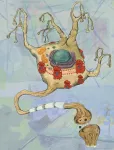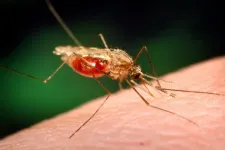(Press-News.org) WASHINGTON — Climate change is heating the oceans, altering currents and circulation patterns responsible for regulating climate on a global scale. If temperatures dropped, some of that damage could theoretically be undone. But employing “emergency” atmospheric geoengineering later this century in the face of continuous high carbon emissions would not be able to reverse changes to ocean currents, a new study finds. This would critically curtail the intervention’s potential effectiveness on human-relevant timescales.
Oceans, especially the deep oceans, absorb and lose heat more slowly than the atmosphere, so an intervention that cools the air would not be able to cool the deep ocean on the same timescale, the authors found.
Stratospheric aerosol injection is a commonly discussed geoengineering concept based on the idea that adding particles to the stratosphere could help cool the surface of the planet by reflecting sunlight back into space. This could help stabilize the planet if warming exceeds the 1.5 degree Celsius (2.7 degrees Fahrenheit) cap set by the Paris Climate Agreement, which the planet is on track to exceed under current emission rates. (Global temperatures surpassed that threshold for several months in 2023 due to a combination of factors in addition to climate change, such as El Niño.)
But whether the injections would work is still heavily debated.
Previous research hints that a steady trickle of aerosol injections would help cool the surface of the planet. But the new study suggests that while an abrupt aerosol injection later this century could provide some ocean cooling, it wouldn’t be enough to nudge “stubborn” ocean patterns such as Atlantic meridional overturning circulation, which some research finds is already weakening.
In that case, preexisting problems resulting from a warmed deep ocean, such as altered weather patterns, regional sea level rise and weakened currents, would remain in place even as the atmosphere and surface ocean cooled.
“The big picture result is that we believe we can control the surface temperature of the Earth, but other components of the climate system will not be so fast to respond,” said Daniel Pflüger, a physical oceanographer at Utrecht University who led the study. “We need to bring down emissions as fast as possible. We’re only talking about geoengineering because the political will for emission mitigation is lacking.”
The study was published in Geophysical Research Letters, AGU’s journal for high-impact, short-format reports with immediate implications spanning all Earth and space sciences.
Warm planet, wild swings
Scientists know the surface of the planet can cool when large volumes of particles are added to the atmosphere because of events such as volcanic eruptions, which naturally emit gases and fine particles. For instance, in 1815, an eruption at Mt. Tambora in Indonesia launched so much material into the air that it cooled the planet the following year.
Aerosol injection is based on a similar principle whereby the atmosphere is made more reflective to send incoming solar radiation back into space, cooling the planet.
Because of this, Pflüger wanted to test how the atmosphere, shallow ocean, and deep ocean would respond to a steady trickle of aerosol injections over decades as opposed to a big, abrupt injection beginning later in the century. Would such an emergency measure be able to reverse ocean changes?
Pflüger and his colleagues simulated two aerosol injection scenarios, both with high carbon emissions. In one scenario, people started slowly adding particles into the atmosphere in 2020. In the other, beginning in 2080, people inject a large initial quantity of aerosols to bring the amount of warming back to 1.5 degrees Celsius, and then continue to add enough aerosols to maintain that level of cooling.
The team found that in the 2020 scenario, gradual stratospheric aerosol injections maintain ocean temperatures, structure and circulation patterns roughly similar to today.
In the 2080 scenario, the abrupt aerosol injection cooled the Earth’s surface, including the top 100 meters (330 feet) of the ocean, to 1.5 degrees Celsius above the preindustrial average in about 10 years. But the deep oceans remained warmer than average, and critical ocean circulation patterns remained altered. The intervention was not entirely successful.
The study shows that aerosol injection “might be able to slow down or prevent climate tipping points from happening in the first place,” said Daniele Visioni, a climate scientist at Cornell University who was not involved in the research. But aerosol injection “cannot magically restore things.”
“We cannot kick the can down the road forever,” he said.
The extreme climate situations modeled here are neither desirable nor likely, Pflüger said. But they provide a good baseline for understanding how Earth systems react to aerosol injections. Ultimately, geoengineering can be useful — but it cannot be the whole solution, he said.
Relying on geoengineering is “in a way, madness,” Pflüger said. “But the situation is already quite mad.”
#
Notes for journalists:
This study is published in Geophysical Research Letters, an open-access AGU journal. Neither the study nor press release is under embargo. View and download a pdf of the study here.
AGU is leading an international, collaborative effort to develop an ethical framework of principles to guide climate intervention research. about the ethical framework here.
Paper title:
“Flawed emergency intervention: slow ocean response to abrupt stratospheric aerosol injection”
Authors:
Daniel Pflüger (corresponding author), Claudia E. Wieners, Leo van Kampenhout, Rene R. Wijngaard, Henk A. Dijkstra, Institute Marine and Atmospheric Research Utrecht. Utrecht, The Netherlands
###
AGU (www.agu.org) is a global community supporting more than half a million advocates and professionals in Earth and space sciences. Through broad and inclusive partnerships, AGU aims to advance discovery and solution science that accelerate knowledge and create solutions that are ethical, unbiased and respectful of communities and their values. Our programs include serving as a scholarly publisher, convening virtual and in-person events and providing career support. We live our values in everything we do, such as our net zero energy renovated building in Washington, D.C. and our Ethics and Equity Center, which fosters a diverse and inclusive geoscience community to ensure responsible conduct.
END
Emergency atmospheric geoengineering wouldn’t save the oceans
Waiting too long to reduce carbon emissions comes at a steep price for the oceans, and relying on rescue via stratospheric aerosol injection isn't a safe bet
2024-02-29
ELSE PRESS RELEASES FROM THIS DATE:
New model of key brain tumor feature could help scientists understand how to develop new treatments
2024-02-29
ANN ARBOR, Michigan — Researchers at the University of Michigan Health Rogel Cancer Center are exploiting a unique biological feature of glioblastoma to gain a better understanding of how this puzzling brain cancer develops and how to target new treatments against it.
The team, led by senior author Pedro Lowenstein, M.D., Ph.D., Richard Schneider Collegiate Professor of Neurosurgery at Michigan Medicine, had previously identified oncostreams as a key feature in glioblastoma development and in more aggressive disease. These highly active, elongated, spindle-like cells ...
Study: Mutations in hereditary Alzheimer’s disease damage neurons without ‘usual suspect’ amyloid plaques
2024-02-29
LAWRENCE — A University of Kansas study of rare gene mutations that cause hereditary Alzheimer's disease shows these mutations disrupt production of a small sticky protein called amyloid.
Plaques composed of amyloid are notoriously found in the brain in Alzheimer’s disease and have long been considered responsible for the inexorable loss of neurons and cognitive decline. Using a model species of worm called C. elegans that’s often used in labs to study diseases at the molecular level, the research team came to the surprising conclusion that the stalled process of amyloid production — not the amyloid itself — can trigger loss of critical ...
Rice lab finds better way to handle hard-to-recycle material
2024-02-29
HOUSTON – (Feb. 29, 2024) – Glass fiber-reinforced plastic (GFRP), a strong and durable composite material, is widely used in everything from aircraft parts to windmill blades. Yet the very qualities that make it robust enough to be used in so many different applications make it difficult to dispose of ⎯ consequently, most GFRP waste is buried in a landfill once it reaches its end of life.
According to a study published in Nature Sustainability, Rice University researchers and collaborators have developed a new, energy-efficient upcycling method to transform glass fiber-reinforced plastic ...
Ice shell thickness reveals water temperature on ocean worlds
2024-02-29
ITHACA, N.Y. – Cornell University astrobiologists have devised a novel way to determine ocean temperatures of distant worlds based on the thickness of their ice shells, effectively conducting oceanography from space.
Available data showing ice thickness variation already allows a prediction for the upper ocean of Enceladus, a moon of Saturn, and a NASA mission’s planned orbital survey of Europa’s ice shell should do the same for the much larger Jovian moon, enhancing the mission’s findings about whether it could support ...
Garrett Isaac Neubauer Center for Cardiovascular Innovation launches at Columbia
2024-02-29
NEW YORK, NY (February 29, 2024)--Columbia University Vagelos College of Physicians and Surgeons (VP&S) today announced the launch of a new center for pediatric cardiovascular innovation, made possible through a visionary gift by Lawrence Neubauer. The mission of the new center is to improve outcomes for patients through groundbreaking research and care and to define the next cures for and future practice in congenital heart disease (CHD)—here and across the world.
In recognition of the transformative generosity of Lawrence Neubauer, the center will be named the Garrett Isaac Neubauer Center for Cardiovascular ...
MSU co-authored study: 10 insights to reduce vaccine hesitancy on social media
2024-02-29
EAST LANSING, Mich. — Effective population level vaccination campaigns are fundamental to public health. Countercampaigns, which are as old as the first vaccines, can disrupt uptake and threaten public health globally.
Even before March 2020, vaccine hesitancy was directly linked to misinformation — false, inaccurate information promoted as factual — on social media. Once COVID-19 reached pandemic status, social media was acknowledged as the epicenter of information leading to vaccine hesitancy, which the World Health Organization, ...
New study: Deforestation exacerbates risk of malaria for most vulnerable children
2024-02-29
Malaria kills more than 600,000 people each year worldwide, and two thirds are children under age five in sub-Saharan Africa. Scientists have found a treatment that could prevent thousands of these deaths: trees. New research conducted at the University of Vermont (UVM) and published today in the journal GeoHealth suggests forests can provide natural protection against disease transmission, particularly for the most vulnerable children.
Malaria spreads through the bite of Anopheles mosquitoes. While malaria is a disease long associated with lower socioeconomic status, the UVM study links deforestation with higher risk of the disease, particularly for ...
DOE announces plans to host an informational meeting and requests expressions of interest for the Thomas Jefferson National Accelerator Facility Management and Operating Contract Competition
2024-02-29
Washington, D.C. – The U.S. Department of Energy (DOE) announced the schedule for upcoming events and submissions associated with the competition for the management and operating contract for the Thomas Jefferson National Accelerator Facility (TJNAF).
TJNAF is a DOE national laboratory and DOE-sponsored Federally Funded Research and Development Center that has a mission focused on delivering breakthrough science and technology in nuclear physics.
DOE will host an informational meeting and site tour on March 27, 2024 at TJNAF to provide information regarding the site to interested parties. ...
Changes in flu circulation means US likely to see vaccines move from quadrivalent to trivalent
2024-02-29
U.S. flu vaccines are likely to move from quadrivalent to trivalent due to a change in circulating influenza viruses, says a University of Michigan researcher.
Currently, all influenza vaccines in the United States are quadrivalent, meaning that they protect against four different flu viruses.
In a new paper published in the New England Journal of Medicine, researchers detail the spread of influenza B/Yamagata virus, which has not been in circulation since early 2020; the regulatory discussions and recommendations on updating vaccines; and the manufacturing considerations ...
Accreditation with commendation awarded to the American College of Chest Physicians
2024-02-29
Glenview, IL– The American College of Chest Physicians® (CHEST) has received accreditation with commendation from the Accreditation Council for Continuing Medical Education (ACCME) and reaccreditation from the Society for Simulation in Healthcare (SSH).
This achievement grants CHEST reaccreditation through November 2029 and places the organization in the highest tier of all continuing medical education (CME) providers, including some of the nation’s most prestigious medical schools and professional medical societies.
“Receiving reaccreditation with commendation from the ACCME is a real testament to the education team at CHEST including both internal ...
LAST 30 PRESS RELEASES:
iPS cells from dish to freezer and back
Deep neural networks enable accurate pricing of American options under stochastic volatility
Collective risk resonance in Chinese stock sectors uncovered through higher-order network analysis
Does CPU impact systemic risk contributions of Chinese sectors? Evidence from mixed frequency methods with asymmetric tail long memory
General intelligence framework to predict virus adaptation based on a genome language model
Antibiotic resistance is ancient, ecological, and deeply connected to human activity, new review shows
Vapes, pouches, heated tobacco, shisha, cigarettes: nicotine in all forms is toxic to the heart and blood vessels
From powder to planet: University of Modena engineers forge a low-carbon future for advanced metal manufacturing
Super strain-resistant superconductors
Pre-school health programme does not improve children’s diet or physical activity, prompting call for policy changes, study finds
Autumn clock change linked to reduction in certain health conditions
AI images of doctors can exaggerate and reinforce existing stereotypes
Where medicine meets melody – how lullabies help babies and parents in intensive care
We may never be able to tell if AI becomes conscious, argues philosopher
AI video translation shows promise but humans still hold the edge
Deep ocean earthquakes drive Southern Ocean’s massive phytoplankton blooms, study finds
Without campus leftovers to pick through, the beaks of this bird changed shape during the pandemic
High-dose antibiotic does not reduce mortality in tuberculous meningitis
How many insects fly in the sky above the USA?
Could cheese protect your brain health?
Who faces more difficulty recovering from stroke?
Colliding galaxies create the brightest, fastest growing black holes at their center
New BrainHealth research reveals tradeoffs on sleep with cannabis use for chronic pain
Aging-US now on ResearchGate, enhancing visibility for authors and readers
'Molecular glue' stabilizes protein that inhibits development of non-small cell lung cancer
Mount Sinai Health System is recognized in 2025 Chime Digital Health Most Wired survey
From prey to predator: How carnivores spread beneficial fungi
Menopause symptoms may be frequent and have negative effects, according to female endurance athletes
US Congressmembers’ responses on X to mass shooting events differ along party lines
KAIST-UEL team develops “origami” airless wheel to explore lunar caves
[Press-News.org] Emergency atmospheric geoengineering wouldn’t save the oceansWaiting too long to reduce carbon emissions comes at a steep price for the oceans, and relying on rescue via stratospheric aerosol injection isn't a safe bet




